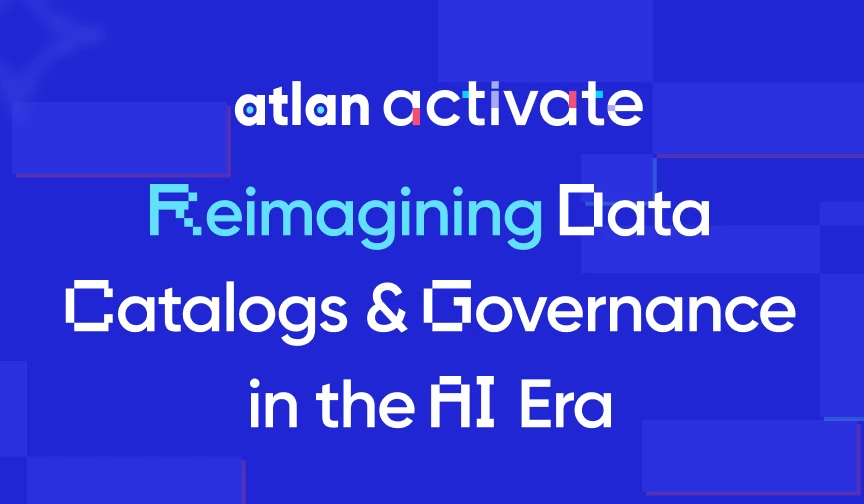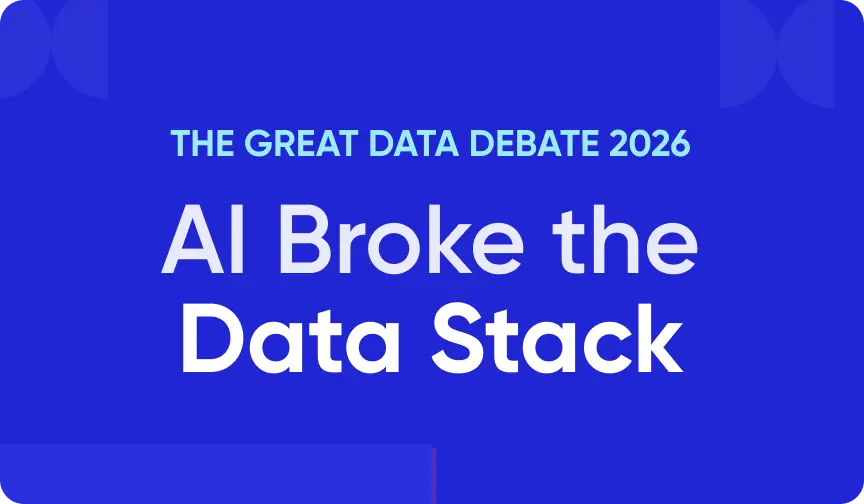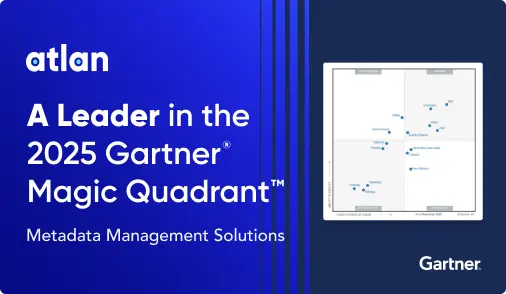Share this article
Traditional metadata is static, siloed, and often outdated—making it difficult to gain real-time insights and ensure data consistency across your ecosystem. Active metadata changes this by enabling continuous access, automation, and intelligent processing across all your data tools.
With an always-on, API-driven approach, active metadata helps organizations optimize costs, improve data quality, and enhance security. By breaking down silos, it powers use cases like governance automation, self-service analytics, and AI-driven decision-making.
Key benefits of active metadata
Permalink to “Key benefits of active metadata”- Real-time data synchronization: Ensures continuous metadata flow across tools, keeping data fresh and relevant.
- Automated governance & compliance: Enables policy enforcement, security classification, and compliance monitoring in real-time.
- Enhanced collaboration: Embeds metadata-driven context into daily workflows, reducing tool-switching and improving teamwork.
- Actionable intelligence: Powers AI-driven insights, automates recommendations, and triggers alerts for smarter decision-making.
- Scalability & adaptability: Supports dynamic metadata exchange across modern data stacks, evolving with business needs.
Gartner predicts that active metadata management will enable organizations to cut the time to deliver new data assets by as much as 70% by 2027. So, let’s understand active metadata, its characteristics, use cases, and management.
See How Atlan Streamlines Metadata Management – Start Tour
Table of Contents
Permalink to “Table of Contents”- What is active metadata?
- The 4 characteristics of active metadata
- Active metadata example
- Active vs. passive metadata: What’s the difference?
- 14 active metadata use cases
- What is active metadata management?
- What does an active metadata management platform look like?
- How can you get started with active metadata management?
- How Atlan helps companies with active metadata management
- FAQs about active metadata
- Active Metadata: Related Reads
What is active metadata?
Permalink to “What is active metadata?”Active metadata refers to a dynamic approach to managing metadata that goes beyond traditional passive storage of metadata. It enables real-time, bidirectional data exchange across various tools in the data ecosystem by utilizing open APIs. This allows metadata to flow seamlessly between platforms, providing contextual information at each touchpoint.
This is what allows active metadata to bring context, say, from Snowflake into Looker, Looker into Slack, Slack into Jira, and Jira back into Snowflake. This continuous flow of metadata ensures a cohesive, context-aware environment across the data stack, enhancing decision-making, automation, and governance.
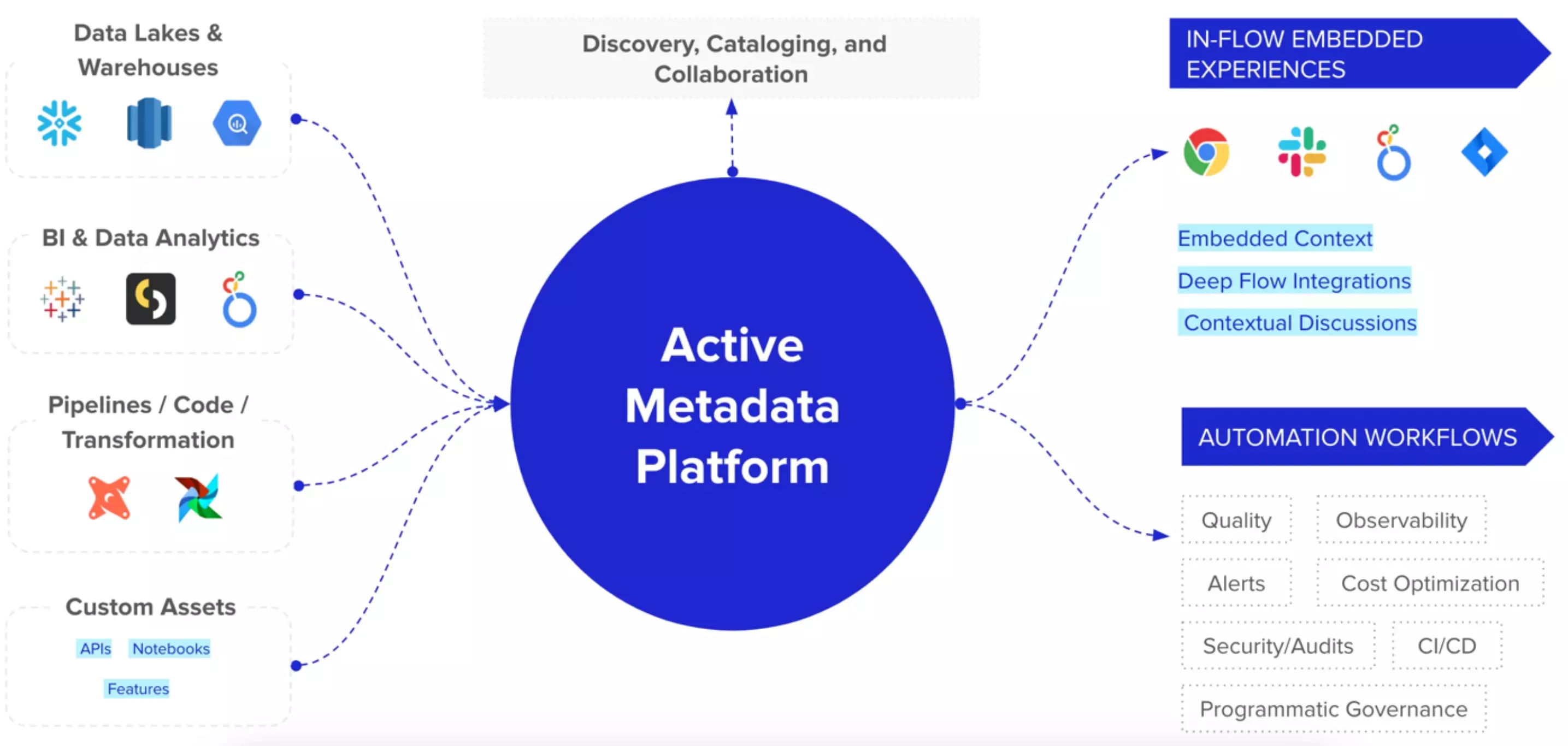
Active metadata leverages open APIs to power the two-way flow of data across the modern data stack. Image by Atlan.
The 4 characteristics of active metadata
Permalink to “The 4 characteristics of active metadata”There are four fundamental characteristics of active metadata:
- Active metadata is always on
- Active metadata is intelligent
- Active metadata is action-oriented
- Active metadata is open by default
#1- Active metadata is always on
Permalink to “#1- Active metadata is always on”Active metadata is always on. This means having the ability to automatically and continually collect metadata from various sources and steps of data flow — logs, query history, usage statistics, and more.
#2- Active metadata is intelligent
Permalink to “#2- Active metadata is intelligent”Active metadata isn’t just about collecting metadata. It’s about constantly processing metadata to connect the dots and create intelligence from it. This means that with active metadata, the system will only get smarter over time as people use it more and it observes more metadata.
So, you can auto-classify sensitive data, use automatic suggestions to document a data asset’s description, send alerts about critical issues, and more.
#3- Active metadata is action-oriented
Permalink to “#3- Active metadata is action-oriented”Active metadata doesn’t just stop at intelligence. It should drive action by:
- Curating recommendations
- Generating alerts
- Making it easier for people to make decisions
- Automatically making decisions without human intervention, like stopping downstream pipelines when data quality issues are detected
#4- Active metadata is open by default
Permalink to “#4- Active metadata is open by default”Active metadata platforms use APIs to hook into every piece of the modern data stack. This makes magical user experiences possible by saving data practitioners from the endless tool- and context-switching.
This is called embedded collaboration, which is when work happens where you are with the least amount of effort.
Read → Stories from the teams at the forefront of data collaboration.
How active metadata works: an example
Permalink to “How active metadata works: an example”Let’s take Spotify as an example to understand how active metadata works.
When you open Spotify, the platform’s algorithm analyzes various types of metadata associated with each song, such as the genre, mood, and tempo to automatically suggest similar songs or artists that you might enjoy. This happens as soon as you listen to a song or play one of your playlists.
Spotify also analyzes the metadata associated with each song or album, such as the artist, release date, and popularity, to auto-classify music into playlists such as “Discover Weekly,” “Release Radar,” and “Daily Mix” that are tailored to each user’s taste. These playlists are constantly updated depending on your listening history and tastes.
So, Spotify can create personalized playlists, categorize its music library, and provide intelligent recommendations, all thanks to active metadata.
Active vs. passive metadata: What’s the difference?
Permalink to “Active vs. passive metadata: What’s the difference?”Both active and passive metadata refers to how we aggregate, store, and use metadata.
The main difference between active and passive metadata is that passive metadata is the standard way of collecting technical metadata — schemas, data types, models, etc. Meanwhile, active metadata is a way of making metadata flow dynamically across the entire data stack.
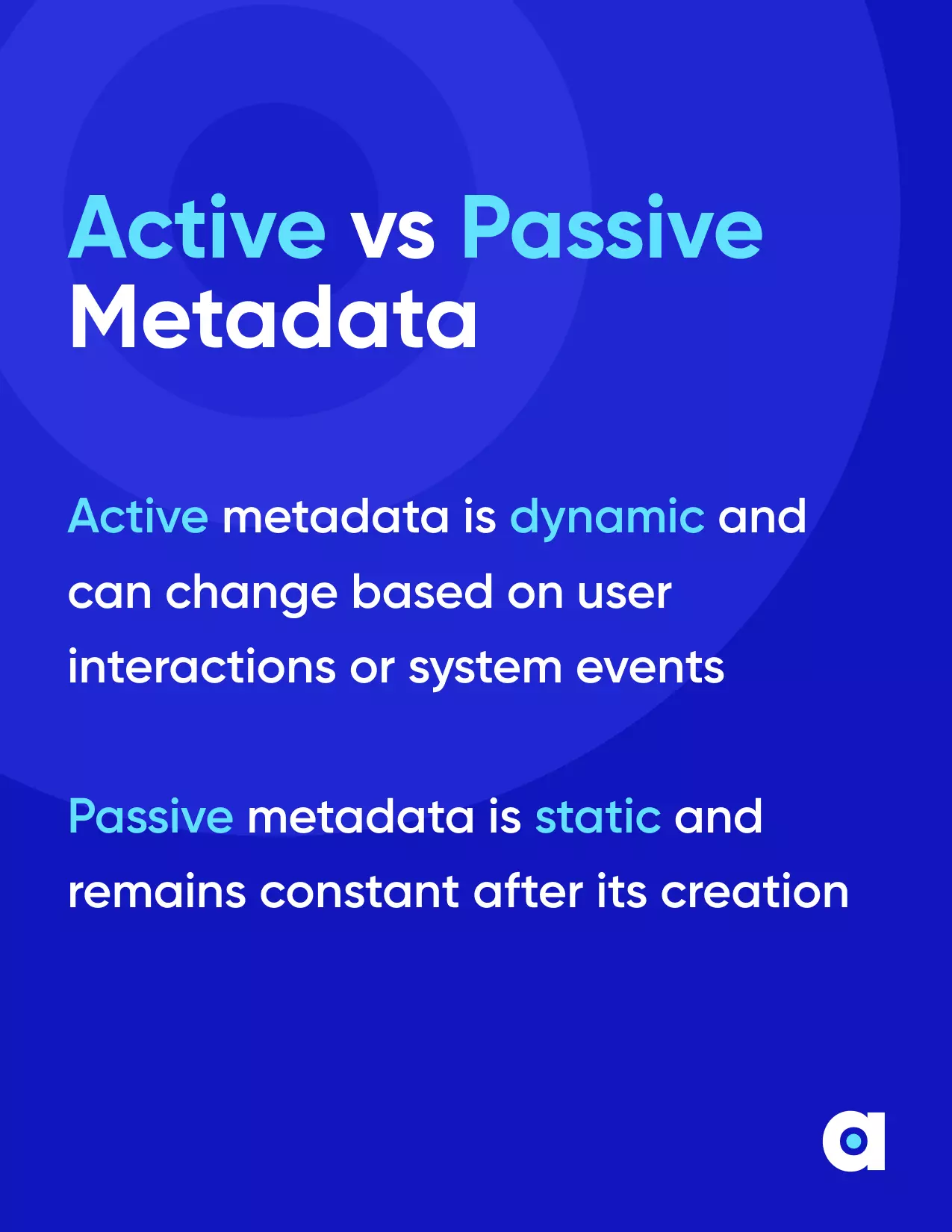
Active vs. Passive Metadata - Image by Atlan.
This enables bidirectional data flow, embedding enriched context and information in every tool in the data stack. So, active metadata goes beyond technical metadata to include operational, business, and social metadata.
Here’s how Prukalpa Sankar, co-founder at Atlan, highlights the difference between active vs. passive metadata:
“Think of passive metadata as putting out information on a personal blog. Every so often, it could get picked up and go viral, but most of the time, it’s just going to sit unseen and unused. Think of active metadata as a viral story. It shows up everywhere you already live in what seems like seconds. It’s immediately cross-checked against and combined with other information, bringing together a network of related context into a larger trend or story. And it sparks conversations, making everyone more knowledgeable and informed in the end.”
14 active metadata use cases
Permalink to “14 active metadata use cases”While there are numerous active metadata use cases, here’s a list of the top 14 enterprise use cases to get you started:
- Optimize data stack spending with dynamic pipeline optimization. Collect runtime metrics from data processing engines and usage metrics from BI tools. Monitor peak access times, identify the most clunky processes, and track assets that get updated the most/least.
- Purge stale or unused assets. Track the popularity of each data asset with usage metadata to know when it was last used or how many people used it. If the asset hasn’t been updated or used in months, then it’s stale or redundant and must be purged.
- Reduce the time spent on the root cause and impact analysis. Active metadata can automate lineage — tracking data flow across the data universe — and reduce the analysis time to mere minutes.
- Instill more trust in your data. Send real-time alerts and announcements about the status of each data asset so that data users are always in the loop.
- Manage security classifications. Active metadata gives you the ability to propagate CIA (confidentiality, integrity, availability) ratings automatically via column-level lineage in real time. This is essential to comply with regulations like GDPR or CCPA.
- Raise security alerts programmatically. Automatically send real-time alerts and announcements about change events to the data security team via channels like Slack or Jira.
- Archive data programmatically. Set up automatic workflows to crawl data, notify the right stakeholders as soon as that data is available, keep track of its storage period, and archive it at the right time to avoid any compliance breaches.
- Generate periodic data security and compliance reports. Understand each data asset fully with 360-degree profiles and explore its relationships with other assets across the data universe via lineage.
- Set up and regulate data access. Define access control policies using contextual metadata — classifications, business glossary, etc. and link it to the relevant data assets and their fields. Set up tag-based or attribute-based access control and propagate it automatically across assets via column-level lineage.
- Streamline analyst service requests. View each data asset – metrics, queries, data sets, etc. – as a product and build GitHub-like repositories for each of these products. Then share those profiles with just a link.
- Streamline data/analytics engineer service requests. Build engineering context by leveraging active metadata so that all users can look up information such as last run status in Airflow or freshness of dbt tags whenever they want.
- Speed up the onboarding of your data team. 360-degree asset profiles offer context about each asset’s origins, ownership, upstream and downstream workflows, quality, freshness, and more. You can trace its full lineage all the way to its source.
- Write better SQL queries. Keep track of SQL queries run for each data asset. From the asset’s profile, you can easily see definitions, recent joins, metrics, and any issues/warnings involved.
- Enrich user experience with BI tools. Bring context into dashboards. Relevant metadata (business terms, descriptions, owners, and lineage) can be pushed into the BI tool.
Learn more → How Nasdaq uses active metadata to evangelize for their data strategy
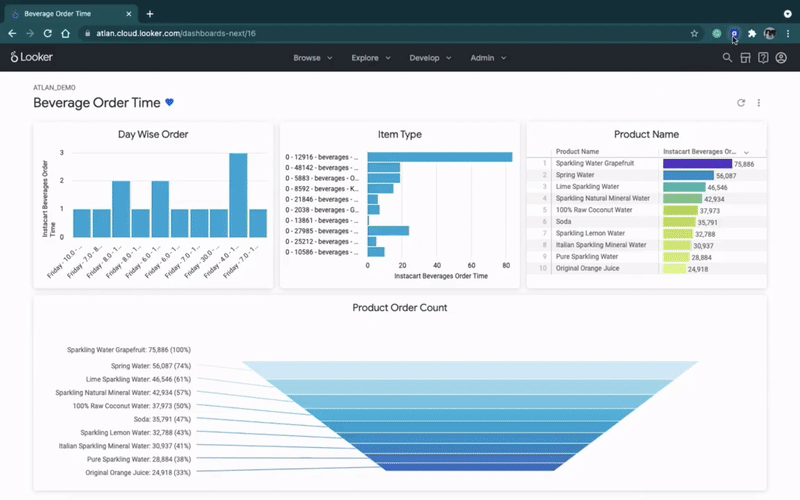
Enriching BI tools with active metadata. Image by Atlan.
What is active metadata management?
Permalink to “What is active metadata management?”Active metadata management is a system for transforming analytical outcomes into operational alerts and suggestions. It detects patterns in data operations, ultimately leading to AI-assisted adjustments of data and corresponding operations.
An active metadata management platform enables the two-way movement of metadata by analyzing all types of metadata from various data sources and then sending enriched metadata back into different tools in the tech stack.
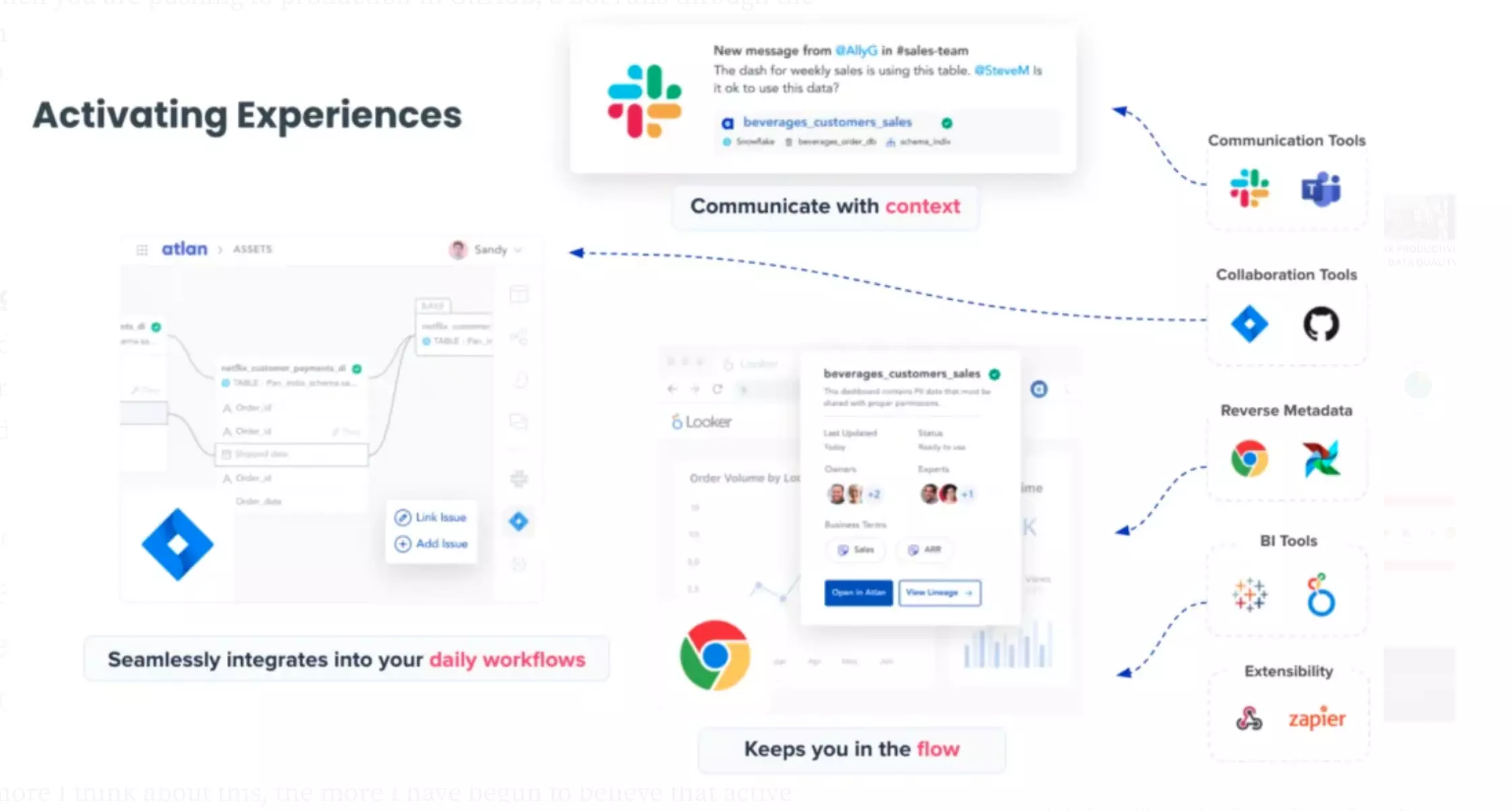
Active metadata platform. Source: Atlan.
Here’s how Prukalpa Sankar, co-founder at Atlan, envisions a world with active metadata management:
“Imagine a world where data catalogs aren’t standalone tools. Instead, a user can get all the context where they need it — either in the BI tool of their choice or whatever tool they’re already in, whether that’s Slack, Jira, the query editor, or the data warehouse. It’s like reverse ETL, but for metadata.”
Active metadata management and the modern data stack
Permalink to “Active metadata management and the modern data stack”Metadata is being generated with incredible speed and variety – and metadata management platforms have struggled to keep up. Gartner even scrapped their famous Magic Quadrant for Metadata Management Solutions and replaced it with a Market Guide for Active Metadata.
The next generation of platforms will need to shift from augmented data catalogs to a metadata ‘anywhere’ orchestration platform.
What does that mean for the modern data stack? With an always-on, active, and intelligent way of handling metadata, the entire modern data stack will support a bidirectional flow of metadata. This will require an active metadata management platform that:
- Imports and exports metadata, workflows, and other optimization strategies
- Uses machine learning to recommend job flows, resource allocation, etc.
- Analyzes metadata across platforms
Let’s further explore the anatomy of such a platform.
Learn more → How to bring modern metadata into your modern data stack.
What does an active metadata management platform look like?
Permalink to “What does an active metadata management platform look like?”An active metadata management platform is always on, intelligent, API-driven, and action-oriented, enabling a bidirectional flow of metadata to ensure embedded collaboration. They’re no longer passive solutions that solve the “too many tools” problem by adding yet another tool — expensive shelfware.
To my many friends/followers doing metadata/catalog startups, I have a request: please integrate the metadata info with my BI tool so that I can see it *while I am doing queries.*
— JosH100 (@josh_wills) April 29, 2022
I have no desire to *ever* visit a third website to just "browse the metadata."
The “too many tools” problem that humans of data face. Source: Josh Wills on Twitter
Core components of an active metadata management platform
Permalink to “Core components of an active metadata management platform”An active metadata management platform sends metadata back into every tool in the data stack. The five core components of such a platform are:
- The metadata lake: A unified repository to store all kinds of metadata, in raw and processed forms, built on open APIs and powered by a knowledge graph
- Programmable-intelligence bots: A framework that allows teams to create customizable ML or data science algorithms to drive intelligence
- Embedded collaboration plugins: A set of integrations, unified by the common metadata layer, that seamlessly integrates data tools with each data team’s daily workflow
- Data process automation: An easy way to build, deploy, and manage workflow automation bots that will emulate human decision-making processes to manage a data ecosystem
- Reverse metadata: Orchestration to make relevant metadata available to the end-user, wherever and whenever they need it, rather than in a standalone catalog
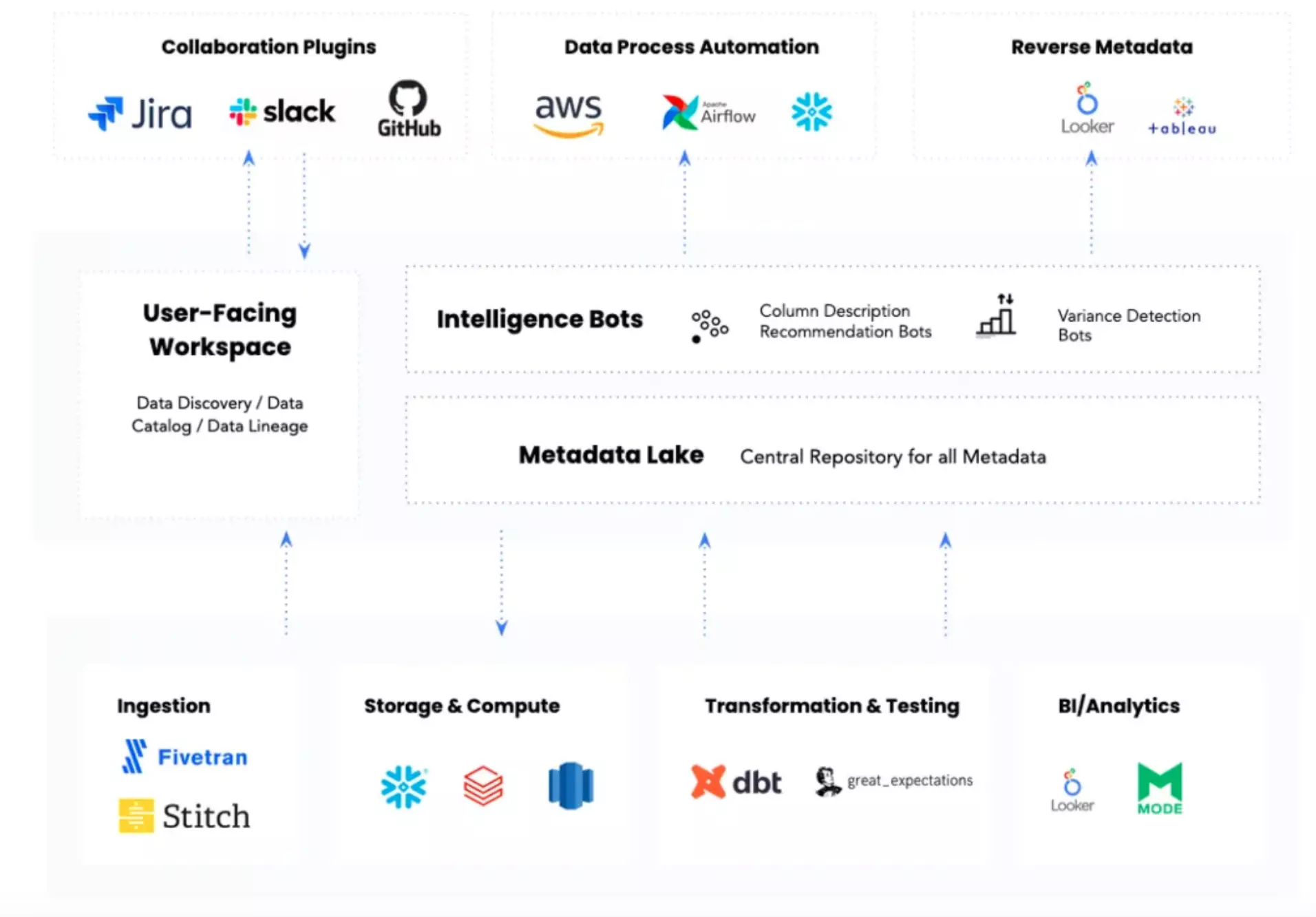
The architecture of an active metadata management platform. Source: Medium.
Explore → Features of an Atlan’s active metadata management platform
How can you get started with active metadata management?
Permalink to “How can you get started with active metadata management?”Getting started with active metadata means starting your journey toward building a more forward-looking stack. The first step is to identify your use cases, and then pick the right tools.
Whether you are trying to compose a data fabric, data mesh, or trying to democratize data across all teams in the organization, the first thing you need to do is to choose metadata management tools that have the ability to use and exchange active metadata.
Learn more → Secrets of a Modern Data Leader
The right active metadata management platform will help you, as Forrester puts it, address the diversity, granularity, and dynamic nature of data and metadata and weave end-to-end visibility into your modern data stack.
With bidirectional communication, collaboration, and data flows, you can set up a living, intelligent, action-oriented data ecosystem that helps you optimize costs, enhance data security, ensure regulatory compliance, and improve data team productivity.
How Atlan helps companies with active metadata management
Permalink to “How Atlan helps companies with active metadata management”CSE Insurance
Permalink to “CSE Insurance”CSE Insurance leverages Atlan’s active metadata to enhance data discovery and streamline the connection between business metrics, KPIs, and data assets. The platform’s lineage capabilities provide real-time impact analysis, enabling teams to understand dependencies and make informed decisions. With Atlan, CSE ensures their data is both accessible and accurate.
Group 1001
Permalink to “Group 1001”Group 1001, a financial services firm, turned to Atlan to automate metadata integration and enable self-service data discovery for their teams. Atlan’s active metadata solution centralizes data and provides clear lineage, empowering business users to explore data independently. This shift has led to significant improvements in productivity and clarity across the organization.
“We could focus more on the higher-value ask, and the higher-value ask is to enable better collaboration within the organization around data. That’s the real reason why I chose Atlan,” says Gu Xie, Head of Data Engineering.
Scripps Health
Permalink to “Scripps Health”Scripps Health uses Atlan’s active metadata platform to create a unified, searchable catalog for easy access to critical data. This ensures data accuracy, fosters trust, and promotes collaboration across the organization. The platform’s interactive features have increased user engagement and made data-driven decision-making more efficient.
“Atlan is robust with a lot of user interactivity in the tool, making our data more accessible and usable across the organization,” says a Scripps Health team member.
Contentsquare
Permalink to “Contentsquare”Contentsquare, a digital experience analytics company, utilizes Atlan to centralize data cataloging, lineage, and dashboards for seamless visibility and ownership of data assets and KPIs. The active metadata platform also enables data engineers to optimize their workflows by understanding the downstream impacts of their work. Atlan’s dynamic space empowers teams to easily access and manage their data ecosystem.
“We needed a go-to space where data cataloging, data lineage, and dashboards are just a click away,” says Sego, a Business Analyst.
Atlan’s active metadata platform empowers organizations across industries to streamline data management, drive efficiency, and foster collaboration. If you’re ready to see how Atlan can transform your data operations, book a personalized demo today and experience the benefits of a unified, self-service metadata solution tailored to your needs.
FAQs about active metadata
Permalink to “FAQs about active metadata”What is active metadata, and how is it different from traditional metadata?
Permalink to “What is active metadata, and how is it different from traditional metadata?”Active metadata continuously connects all tools within the data stack via open APIs, allowing for dynamic, two-way data flow. Unlike traditional metadata, which is static and siloed, active metadata automatically collects, processes, and shares real-time insights, promoting collaboration, automation, and better decision-making.
How does active metadata improve data governance and collaboration?
Permalink to “How does active metadata improve data governance and collaboration?”Active metadata automates processes such as lineage tracking, real-time alerts, and policy enforcement. By integrating metadata directly into tools like Slack, Jira, and BI platforms, it bridges team silos, accelerates root cause analysis, and enhances collaboration, making governance more seamless and efficient.
What are the key use cases for active metadata in enterprise data management?
Permalink to “What are the key use cases for active metadata in enterprise data management?”Active metadata streamlines enterprise data management by optimizing costs, automating data classification for compliance, reducing root cause analysis time, improving data trust through real-time updates, and personalizing user experiences within BI tools.
How can I implement active metadata in my current data architecture?
Permalink to “How can I implement active metadata in my current data architecture?”Begin by identifying specific use cases such as compliance or cost optimization. Select a platform like Atlan, which supports bidirectional metadata flow and integrates with your stack through APIs. With such a platform, you can actively manage metadata and embed contextual insights across workflows.
Why is real-time integration important for active metadata?
Permalink to “Why is real-time integration important for active metadata?”Real-time integration allows metadata to flow instantly between systems, ensuring decisions are based on the most current context. This rapid, continuous feedback loop facilitates quicker response times to quality issues and operational changes, improving productivity and minimizing downtime.
How does active metadata ensure data quality and compliance?
Permalink to “How does active metadata ensure data quality and compliance?”Active metadata automates key tasks like data classification, lineage tracking, and policy enforcement. It sends real-time alerts for anomalies or compliance risks, helping organizations proactively manage sensitive data and stay aligned with regulations such as GDPR or CCPA.
Active Metadata: Related Reads
Permalink to “Active Metadata: Related Reads”- Databricks Summit 2025: What to Expect at the Data + AI Summit
- Data Catalog: What It Is & How It Drives Business Value
- What Is a Metadata Catalog? - Basics & Use Cases
- Modern Data Catalog: What They Are, How They’ve Changed, Where They’re Going
- Open Source Data Catalog - List of 6 Popular Tools to Consider in 2026
- 5 Main Benefits of Data Catalog & Why Do You Need It?
- Enterprise Data Catalogs: Attributes, Capabilities, Use Cases & Business Value
- The Top 11 Data Catalog Use Cases with Examples
- 15 Essential Features of Data Catalogs To Look For in 2026
- Data Catalog vs. Data Warehouse: Differences, and How They Work Together?
- Snowflake Data Catalog: Importance, Benefits, Native Capabilities & Evaluation Guide
- Data Catalog vs. Data Lineage: Differences, Use Cases, and Evolution of Available Solutions
- Data Catalogs in 2026: Features, Business Value, Use Cases
- AI Data Catalog: Exploring the Possibilities That Artificial Intelligence Brings to Your Metadata Applications & Data Interactions
- Amundsen Data Catalog: Understanding Architecture, Features, Ways to Install & More
- Machine Learning Data Catalog: Evolution, Benefits, Business Impacts and Use Cases in 2026
- 7 Data Catalog Capabilities That Can Unlock Business Value for Modern Enterprises
- Data Catalog Architecture: Insights into Key Components, Integrations, and Open Source Examples
- Data Catalog Market: Current State and Top Trends in 2026
- Build vs. Buy Data Catalog: What Should Factor Into Your Decision Making?
- How to Set Up a Data Catalog for Snowflake? (2026 Guide)
- Data Catalog Pricing: Understanding What You’re Paying For
- Data Catalog Comparison: 6 Fundamental Factors to Consider
- Alation Data Catalog: Is it Right for Your Modern Business Needs?
- Collibra Data Catalog: Is It a Viable Option for Businesses Navigating the Evolving Data Landscape?
- Informatica Data Catalog Pricing: Estimate the Total Cost of Ownership
- Informatica Data Catalog Alternatives? 6 Reasons Why Top Data Teams Prefer Atlan
- Data Catalog Implementation Plan: 10 Steps to Follow, Common Roadblocks & Solutions
- Data Catalog Demo 101: What to Expect, Questions to Ask, and More
- Data Mesh Catalog: Manage Federated Domains, Curate Data Products, and Unlock Your Data Mesh
- Best Data Catalog: How to Find a Tool That Grows With Your Business
- How to Build a Data Catalog: An 8-Step Guide to Get You Started
- The Forrester Wave™: Enterprise Data Catalogs, Q3 2024 | Available Now
- How to Pick the Best Enterprise Data Catalog? Experts Recommend These 11 Key Criteria for Your Evaluation Checklist
- Collibra Pricing: Will It Deliver a Return on Investment?
- Data Lineage Tools: Critical Features, Use Cases & Innovations
- OpenMetadata vs. DataHub: Compare Architecture, Capabilities, Integrations & More
- Automated Data Catalog: What Is It and How Does It Simplify Metadata Management, Data Lineage, Governance, and More
- Data Mesh Setup and Implementation - An Ultimate Guide
Share this article

